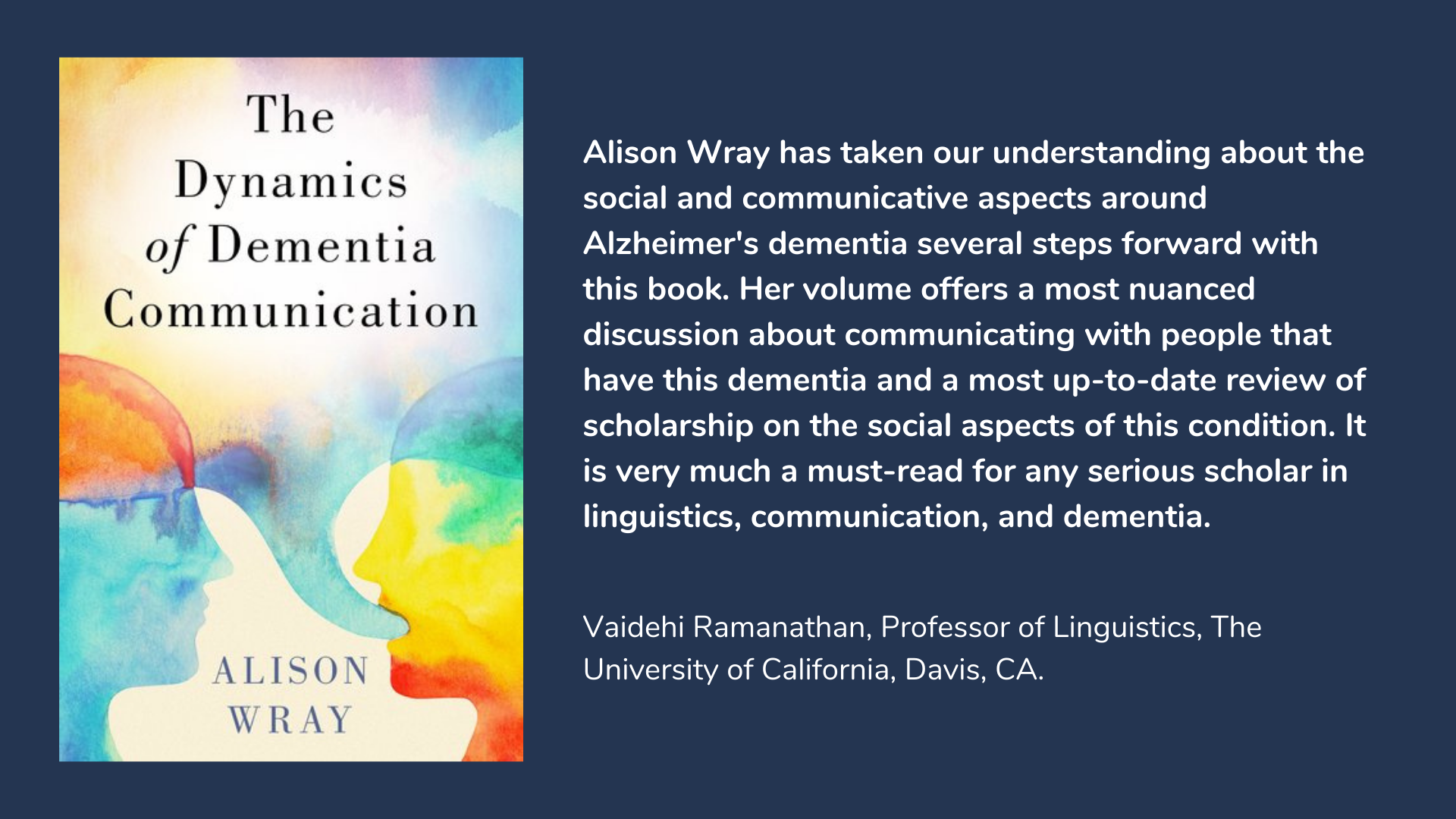The Dynamics of Dementia Communication
Professor Alison Wray
WINNER of the 2021 British Association for Applied Linguistics Book Prize
(Comment from the judges)
This is an impressive volume which constructs a very wide-ranging umbrella framework for understanding dementia communication, an area of increasing importance in our society. The book presents some very big and bold questions about how best to communicate with people living with dementia from the very start, and as the work proceeds, these questions are answered in a detailed and meticulous way.
RUNNER UP The American Association for Applied Linguistics Book Award 2022
(Comment from the judges)
This book is a beautifully written, interdisciplinary tour de force that focuses on the human experience of dementia and, specifically, how the illness affects communication, for both the person living with dementia and their interlocutors. With evidence-based guidance for how to support and look after people with dementia, it will appeal not only to linguists, but to medical workers and caregivers, as well. The book offers a critique of popular conceptions about the diseases of dementia and their symptoms. Each of the chapters displays - and calls for - sincere compassion and empathy for persons with dementia and for their caregivers and interlocutors. Furthermore, the book reflects the researcher’s trajectory and growth as an expert in the field by building on her earlier research on formulaic language. As such, it is an inspiring example of how expertise in one area (formulaic language) can build bridges to other areas of applied linguistics (language in healthcare).
Book Description
More than an intellectual tour-de-force, it is an act of compassion. (Robert Schrauf, PhD, Professor and Department Head of Applied Linguistics, Penn State University, University Park, PA)
It is well recognized that when people are living with a dementia, effective communication can be a challenge for both them and those they interact with. Despite a plethora of good advice, it can be surprisingly hard to sustain constructive communicative behaviours and to integrate them successfully into routine daily care and interaction.
The Dynamics of Dementia Communication asks why that is. What is it about communication, as a human social and cognitive practice, that makes it so difficult to manage the disruptions caused by dementia? Why is it so common to feel awkward, confused or irritated when talking with a person living with a dementia? Why is the experience of living with a dementia so personally and socially devastating? What approaches to communication would work best, and why?
To answer these questions, the book integrates information from a wide range of different sources, covering the biological, social, and emotional factors associated with the dementia experience. New concepts and theoretical perspectives offer novel ways of thinking about the challenges of communication generally, and in the context of dementia. Topics explored include whether it is acceptable to deceive people living with a dementia and why society's failure to support people living with a dementia and their carers is so devastating. The final chapter suggests what people living with a dementia need if communication is to promote and protect everyone's well-being.
By providing a deeper understanding of what topples the best-intentioned attempts at interaction, and by explaining why poor communication affects everyone involved, this book sets new agendas for improving the welfare of people living with a dementia, their families, and professional carers.
Professor Wray's excellent and stimulating book could become the 'go to' resource for in-depth discussions about language, linguistics, communication, and brain changes associated with particular types of dementia. Complex issues are thoughtfully presented and explained in a clear, compelling narrative. The text is scholarly without being stuffy or pedantic, and Parts and Chapters can be read as individual units of interest. Wray obviously has a working knowledge of communication and relationships with people living with a dementia, their caregivers, and professional partners. The warmth, humour, and expertise invite us to join in the explorations alongside the author. She invites us to ponder our own knowledge and assumptions and improve our person-centred practice. We couldn't ask for much more from a book in this field. (Danuta Lipinska, Specialist in Ageing & Dementia Care, Training Consultant, Counsellor, Supervisor, 'My Home Life' Action Learning Facilitator, London, England)
The Dynamics of Dementia Communication is available to buy from your favourite bookseller and online in print and kindle versions from Amazon.

Professor Alison Wray took her BA and D.Phil in linguistics at the University of York, UK. After completing a postdoctoral research project on singers' pronunciation in the Department of Music at York, she held a lectureship in linguistics at the then College of Ripon and York St John (now York St John University). In 1996 she was appointed Assistant Director of the Wales Applied Language Research Unit at Swansea University, and in 1999 became a Senior Research Fellow at Cardiff University.
Professor Wray became a (full) Professor at Cardiff in 2005 and a Research Professor in 2007. She is internationally known for her research into formulaic language, publishing two seminal books on the topic in 2002 and 2008. Since 2008 Professor Wray has focussed on understanding the challenges of communication by and with people living with a dementia and has presented on this topic in countries around the world.
A critically acclaimed author, Professor Wray's other published works include: Why Dementia Makes Communication Difficult: A Guide To Better Outcomes (Jessica Kingsley 2021).
CLICK HERE for more videos in the series.





